Not your average USAs recap⏱
Lap 69: Sponsored by Tracksmith
Tracksmith is a brand for runners, inspired by a deep love of the sport. Their Spring/Summer Collection is now available and features staples thoughtfully designed for this season of hard training and racing in warmer weather. From their ultra-versatile Session Tee, cut from a silky soft stretch knit, to the soft, yet supportive Allston Half Tights, these pieces are built to work as hard as you do.
As the temperatures heat up in the coming months, you can't go wrong with their Twilight pieces, which are ultra-light, breathable and practically disappear while you're running. In the spirit of twilight, Tracksmith is hosting a series of 5ks through the months of July and August in 8 cities in the US. These twilight 5ks focus on getting you to your fastest time with pacers, a fast track, and a great environment. For more information, please go to tracksmith.com/twilight5000.
For our Lap Count audience, new customers can get $15 off of an order of $75 or more in the month of June, by using the code Lap at checkout.
1500 meters of chaos 👨🏫
How flashy was the PowerPoint presentation that convinced World Athletics that the ranking system was a good idea? I have not flipped back and forth between so many pages to figure out what the hell happened after that 1500m since I read Infinite Jest, and the outcome in both instances was the same: I barely – at best – “got it.”
It was chaos after the race to figure out who made the team, since coming in only a few guys had either the standard or enough WA points. And that was even with this sort of hectic outcome essentially assured from the gun. When the race went out in 49 seconds through 300m, half the field immediately became irrelevant.
Fortunately at least one athlete’s qualification for the world team wasn’t up for discussion. Cooper Teare’s 51.8 final lap to win left no doubt in anyone’s mind that we’d be seeing him back on the Hayward track in a couple of weeks. Remember when the whole world got mad at him for time trialing? Well it all seems to have worked out just fine for Cooper.
In second was Illinois’ Jonathan Davis, who ran the race of his life after finishing sixth at NCAAs. However, the collegiate season doesn’t exactly lend itself to chasing times or points and so despite his valiant effort, he won’t be repping Team USA, depriving fans of a real Cinderella story. Just behind Davis was The Lap Count Certified Fast Finisher, Josh Thompson. Although he hadn’t run under 3:35.00 this year, Thompson was ranked 39th in the world, plenty high enough to not stress about pace since the 1500 takes the top 45 ranked athletes regardless of their season’s best.
For those keeping score at home, that’s two qualifiers out of the top three finishers. Surely one only needs to look one spot further to lock in the team? Ho, buddy! That’d be too simple!
In fourth place was Empire Elite’s Eric Holt, who for a moment looked like he was going to steal the show and win the damn thing! Even if he had, it’s not abundantly clear that would have been enough, as he came in ranked 73rd. Running well at USAs isn’t worth quite as much as you’d expect — point allocation factors in the meet category and place, but the time carries the majority of a performance’s weight. Even though this was by far and away the best race of the unsponsored Holt’s life, it technically won’t be included in his top three performances from the last year and therefore doesn’t even help his ranking.
And in fifth place was Oregon’s Reed Brown, who much like Davis had no statistical shot once the race went slow. Which means the third spot goes to sixth place finisher, Johnny Gregorek, which while a confusing outcome for fans, delights me to no end, as he is the person I probably talk to most in the world besides maybe my wife (maybe he’ll get slotted down to third once my daughter starts talking). When Johnny got up off the track with a blood-filled mouth after taking a tumble at the line, I yelled down to him in one of the riskiest statistical moves of my life and told him that he may have made it.
I quickly crunched the numbers, confirmed my understanding of the rules, then ran back to the mixed zone where I was greeted by some of the most knowledgeable people in the sport who were also still trying to figure out the team.
Cautiously I shared my math, but if the nerdiest group of people in the sport are still trying to wade through a year’s worth of results in order to figure out who’s on the men’s 1500m team ten minutes after the race is over, then my god is it the stupidest system in the entire world and I can’t decide if those consultants are terrible at their job for making this up or brilliant for being able to sell it to anyone!
Welcome to the mixed zone 🎤
I’ve spent a good amount of time in mixed zones throughout my life, but never on this side of the fence. It’s a struggle to define whatever (looks around the room) “this” is, because I don’t consider myself a journalist, although occasionally I do write some things that border on journalism. I’m openly a fan of the sport, which I am sure goes against some made up rule somewhere, and a lot of the people I am covering are personal friends — or in the case of the preceding section of my newsletter, my BEST FRIEND. I am okay with The Lap Count being athlete-centric and my goal is to use this platform to build them up, not tear them down.
So admittedly, one part of the job that I really struggled with is talking with athletes who didn’t make the team and were devastated about it. When Clayton Murphy walked through, I felt his pain and completely froze when I had the opportunity to ask him a question about the race. I’ve felt that exact heartbreak before and I know although he was completely willing to talk about what had transpired just two minutes before, he was clearly still digesting it and probably wanted to go find his family for comfort.
I see the hate that athletes like Sha’Carri Richardson and Cole Hocker got for not talking to the media. And I understand the frustration from fans who want to know what happened. “But if we want to be considered a professional sport then the athletes should have to answer questions.” This isn’t pro basketball or football where there are overarching, powerful, monied leagues with that power — the athletes don’t have to say a word. And they also don’t have the time or space to process their results, let alone take a shower and change out of their uniforms, before being thrust in front of cameras — they have to walk through the media tent before even getting their trainers back on.
When Sha’Carri returned to the mixed zone to address the media, she made some strong points. Extending some empathy to athletes can actually make for better interviews as they feel comfortable and like a peer, rather than someone to extract soundbites from. And these points resonate even further when you consider that in a sport largely dominated by Black superstars, there hasn’t historically been a very diverse media pool covering them. Thankfully, that’s all seemingly beginning to change.
A lot of the awesome, younger reporters I got to spend time with this past weekend put their own spin on the traditional interview, and it led to some truly memorable, insightful, and entertaining conversations. Jasmine Todd and Katelyn Hutchison were able to get a great post-race interview with Sha’Carri because she trusted their intentions and that they would share her voice fairly. Similarly, Emma Coburn told me after her incredible interview that it was easier to be vulnerable when it’s a friend asking the questions and not a stranger.
If we want to attract new, young fans to the sport, then we also have to cater to what they like to watch. The old-school, purportedly objective press asking “tough questions” is a necessary facet of coverage, but so are the disarming TikToks that show that the athletes we often regard as robots on the track are also fun people worth cheering for off of it.
Where is everybody? 🙈
Much has been made of the poor attendance in Eugene for the US Championships and I can’t sugar coat it — it was bad. In the already limited pool of track fans that exist, how many of those have 12 unused days of PTO and an extra $10,000+ lying around? If you are in the target audience of someone who might be interested in attending a US Championships, then the likelihood is that you have already been to Eugene on a couple occasions in the last decade and probably have at least one loved one begging you for the love of God can we please not take another family vacation around a track meet where you run off and galavant with all your buddies?
Eugene is a nice town, and undeniably an incredible place to be a track fan! But unless you’re a Duck alum or a diehard Ken Kesey fan, the primary selling point for taking a Eugene-based vacation is the track meet itself. And if you had to choose between using up said vacation time and spending thousands of dollars to see a track meet, would you choose USAs, or would you choose Worlds, namely the first ever Worlds held on US soil? Yeah, me too.
I’d have loved to see this past weekend’s action held in another mid-size city instead, to see if attendance would have been any better by not being diluted to another, similar event happening so soon. Find an enthusiastic host organization in a semi-densely populated area on the right side of the country, and see if there being more people within driving distance, who won’t have such an easy time getting out to Worlds would improve fan turnout. And for those who couldn’t physically be at the meet, over 77% of the country lives in the eastern and central time zones, so theoretically it’d be a more readily consumed television product, too. (Please email me your suggestions.)
I’m not trying to disparage TrackTown in the slightest. They put on a hell of a meet and the new facilities are among the best in the world. I just hate seeing USAs relegated to the role of opening act for the headliner scheduled a couple of weeks later — only absolute diehards are willing and able to show up for both.
But for the average, non-attending viewer, for which we need ten-thousand more, attending a meet is only a few-hour-long commitment and a great on-ramp to more geeked out track fandom. Based on the number of people that read this newsletter alone, I know there are over ten thousand fans of this sport who would love to attend the biggest domestic meet annually. The empty stadium is not representative of the state of the sport.
Rumors are that ticket sales for the World Championships are going well and I believe the excitement of watching this past weekend will entice more Americans to make the trip. But maybe after this summer, we test the strength of this relationship, try seeing other people cities, and learn if distance truly makes the heart grow fonder.
In partnership with WCH OREGON 22
Team USA put on a show at the USATF Outdoor Championships in qualifying for the World Athletics Championships Oregon22. In two weeks the best athletes in the world will be heading to Oregon, but are you? The likes of Ryan Crouser, Sydney Mclaughlin, and Noah Lyles will be competing in our backyard at Hayward Field at the University of Oregon – but Team USA needs our support! Cheer on the greatest American track and field athletes as they fight for global titles on home soil July 15-24.
The top 5 redemption arcs from the 2022 Champs
EVAN JAGER
What is it about the steeplechase and domestic dominance? Between 2012 and 2018, Evan Jager won all seven national championships — if he was lining up, it was basically as a formality. And then the injuries began and the guy who was knocking down the door of the eight minute barrier suddenly looked human. It was hard watching Evan run 8:34 at the start of this season because he still looked like Evan Jager, but just not as fast. Luckily, the clutch gene seemingly hasn’t become recessive. When it mattered most, Evan found a way to grab the standard and finish second in 8:17.29. We didn’t always appreciate how gracefully and easily those titles had come, but seeing how much he had to grind for this hopefully put them — and this gutsy performance — into better perspective. I think back to the “2020” Olympic Trials when Evan asked me a few too many eager questions about how my retirement was going for me to not assume he was mulling his own — there was no such conversation this time around.
EMILY INFELD
Some people make it easy to root for them. The 2015 bronze medalist hadn’t made a team since 2017 and had worried those days were over. To break the many year-long injury cycle, Infeld practiced patience this fall and re-established her health with a steady base followed by a string of promising but not out-of-this-world performances. This year’s 10,000m champs looked like her shot, but ended in heartbreak again as she was narrowly out-leaned for the third and final spot. With a month to summon her old college 1500m speed in practice, things finally clicked in the final mile during a tactical 5000m under the sun. Although Infeld’s official mile best is 4:30, she closed the last 1600m in 4:25 on Sunday, good enough to make the team — though to be fair, she did have a running start.
CHASE EALEY
The 2019 US Outdoor and 2020 Indoor Champion struggled at last year’s Olympic Trials, finishing a disappointing fifth place. So she left Arizona and moved to the United Kingdom to team up with friend Sophie McKinna. Working with a new coach and training partner, Ealey refined her technique and found her groove. After finishing second at the World Indoor Championships, she is now undefeated outdoors and threw a world leading mark of 20.51m to reclaim the US title. That mark is the second farthest ever by an American, only bettered by Michelle Carter, who has announced her retirement.
MELISSA JEFFERSON
The odds are that half of you don’t even know which Carolina Coastal Carolina is in — but Melissa Jefferson is putting the mid-major on the map this year! The college junior entered the season with a 100m personal best of just 11.22 seconds, though she was the upset victor in the 60m at NCAA Indoors. Unfortunately she wasn’t able to repeat that magic two weeks ago in Eugene, finishing 8th in the NCAA 100m final. But we should have listened to Coach Goodman who told us this was coming. In the US semi-final she improved her best to 10.82 (+0.5) before dropping a 10.69 (+2.9) to run away from one of the deepest fields of all-time. You’ll remember Melissa’s name now — and that Coastal Carolina’s in South Carolina.
SINCLAIRE JOHNSON
When Sinclaire Johnson won the 2019 NCAA 1500m Championship, the rest would, as they say, not simply be history. A couple weeks later she finished a nail biting fourth at the US Championships before joining the most dominant distance running group in the country, the Bowerman Track Club. Yet while there, she struggled and after a disappointing 12th place finish at the Olympic Trials, made the tough decision to transfer allegiance to the Union Athletics Club. That’s been confirmed as a good move for her, as Johnson followed up that 3:58.85 from Pre earlier this season with her first US Championship, capped off with a negative split 2:02.3 final 800m. If you need some context to appreciate just how wild that is, the US standard for the open 800 was 2:02.50!
The point heard ‘round the world 👉
There were a few too many people that I saw out there who dropped out because they had the bye. I had 500 people come up to me, ‘you gonna race the next round? you gonna race the next round?’ Why would I not? This is MY championship. I am not just gonna let it go! —Noah Lyles
Because the 2019 World Champions receive an automatic bye into the 2022 World Championships, it wasn’t necessary for them to run the US Championships — unless you want to win the US Championship. Previous rules required those athletes to still line up to race, but this year USATF established a new precedent, allowing Dalilah Muhammad to rest up rather than risk hurting a sore hamstring further. Others were offered the same opportunity and took varying degrees of advantage of it.
As he fights a case of bursitis in his right foot, Donavan Brazier decided to opt out of the semi-finals after posting a season’s best and the fastest time of the day in the 800 (1:46.49). Despite a CITIUS prediction contest around his final time, Grant Holloway chose not to run the last round of the 110 hurdles after going 13.03 for what was also a season’s best and fastest time of the day. Nia Ali won her 110 hurdles semi in 12.45 for her season’s best before DNSing the final and a 9.87 second round was enough for Christian Coleman in the 100m.
Since the majority of my rooting interest generally stems from things I deem as being favorable for the health of the sport, I like Noah Lyles. I appreciate the pride he and DeAnna Price (who finished fourth) took in their national title defense. Did his point in the general direction of Erriyon Knighton as the two crossed the finish line potentially wake up a sleeping giant? I’ll tell you in a couple weeks. And I am sure an extra few people will be checking in to find out for themselves because of it.
Athletes should always choose to do what they think is best for them within the confines of the rules. Obviously, I’d have loved for every American World Champion to compete at USAs. Skipping a final just because you can, without valid health concerns doesn’t send a great message to fans. USATF awarded $8,000 per national championship and each individual’s contract probably raised the stakes with an additional $25,000 or more. Let’s not forget that money and honor was not enough incentive to make athletes race next time we talk about how to fix the sport.
While not a perfect fix, it is fairly easy to at least fill the open lanes. There is no reason someone likeAaron Mallet can’t be placed in the final when Holloway scratches — especially because someone of his caliber has the potential to fill that void and possibly make a team. Look no further than Josh Thompson being the 12th man into the 1500 final and still earning his USA kit.
Who made worlds? 🌎

There is a reason it isn’t called field and track. It’s no secret that the altius and fortius side of the sport receives significantly less love than their oval, citius counterpart. And that fact is reflected financially. 89% of track athletes who made the US team were sponsored, while just 50% of those in field events were. But that doesn’t take into account the college kids — of the 19 that made it, many may soon find themselves on the other side of a degree and left wondering where all the wonderful support and infrastructure suddenly went.
In many regards, college athletes have a huge advantage in comparison to many unsponsored professionals who are forced to budget their time, money, and energy carefully to make training and competing possible. This is where a federation might theoretically want to step in and help bring some level of equality between the two sides of the sport, however, the opposite is happening instead. USATF is cutting the budget of many athletes who are currently based out of the Olympic Training Center in Chula Vista — the closest thing to a college environment that most top level athletes, particularly field eventers, have available. The setup provides food, housing, coaching, and facilities for numerous athletes and has enabled the likes of Will Claye, Chris Bernard, Keturah Orji, Laulauga Tausaga-Collins, Rachel McCoy, Ariana Ince, Erica Bougard, and others to represent Team USA.
Imagine being so dedicated to wanting to be the best in the world at something that you are willing to still live in dorms to make that a reality! And despite this arrangement being incredibly effective at producing medals, those who benefited from the stability will now be forced to relocate and find new and likely less ideal situations. Rather than taking away the Olympic Training Center, we should be replicating it.
Rapid Fire Highlights 🔥
At the U20 Championships, Juliette Whittaker ran 1:59.04 to break Mary Cain’s high school 800m record. The time would have placed sixth in the senior final, where she likely would not have had to lead.
Ukrainian athletes were invited to partake in the US U20 Championships in order to achieve their qualifying standards for Colombia. Not only did Valeriia Sholomistska hit the mark, she won the race walk in the process.
Shericka Jackson ran a world leading 21.55 to win the 200m at the Jamaican National Champs to beat many time Olympic gold medalists, Elaine Thompson-Herah and Shelly-Ann Fraser-Pryce.
Keira D’Amato (31:17) and Leonard Korir (28:00) won the BAA 10K.
Oregon head coach Robert Johnson will not have his contract renewed for next season after seventeen years with the university.
Colleen Quigley was forced to miss the steeplechase final after suffering a stress reaction in her foot during the prelims.
Wilfried Happio was assaulted 20 minutes before his race at the French Champs. He still won the 400mH race wearing an eye patch.
At the Irish Champs, the 100mH was won in a pedestrian 15.63 seconds. That’s because Matthew Behan was running into a 8.3 m/s headwind!!!!
Darrell Hill is filing a grievance with USATF about the way his protest was handled by officials during the championships after disagreeing with a called foul on a throw that would have qualified him for Worlds.
The women’s Bowerman finalists notably excluded Jasmine Moore, who won both the long and triple jump NCAA crowns during the indoor and outdoor season, in addition to four SEC titles. Although the postseason doesn’t technically count for the award, Moore made the World team in both events as well. Floridians are also up in arms about the men’s finalists. And c’mon, the postseason really ought to count, right?
Our deepest condolences to Devon Allen and his entire family as his father passed away this weekend. How he mustered up the strength to still compete and make the US team is truly unbelievable.
Alina McDonald has given up her spot on the US team after finishing second in the pole vault as she does not compete on Sundays for religious reasons, which is when the event is contested at Worlds.
I highly recommend checking out this Twitter thread and especially the comments from Aaron Mallet, Natasha Hastings and Alaysha Johnson. You may not agree, but this controversial take has more merit than it may seem on the surface…
Thank you to Tracksmith for sponsoring this week’s newsletter! If you are mad at me for not mentioning Sydney’s WR, Athing Mu, Kerely’s incredible 100s, Grant last mile, or anything else! Check out the CITIUS MAG newsletter and subscribe.



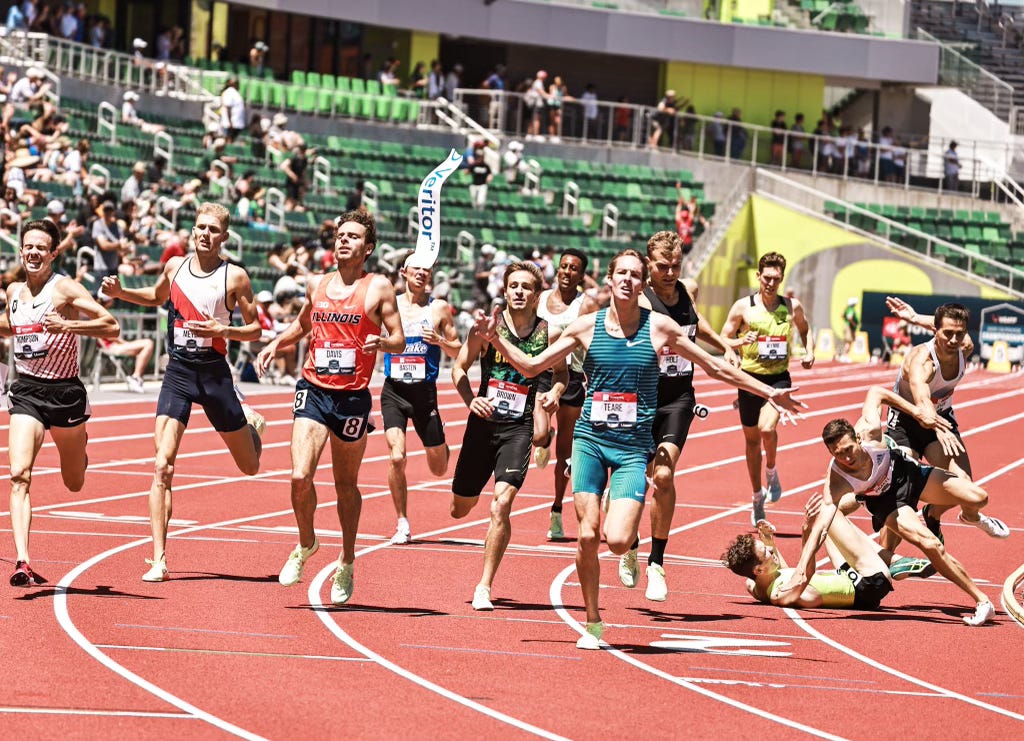
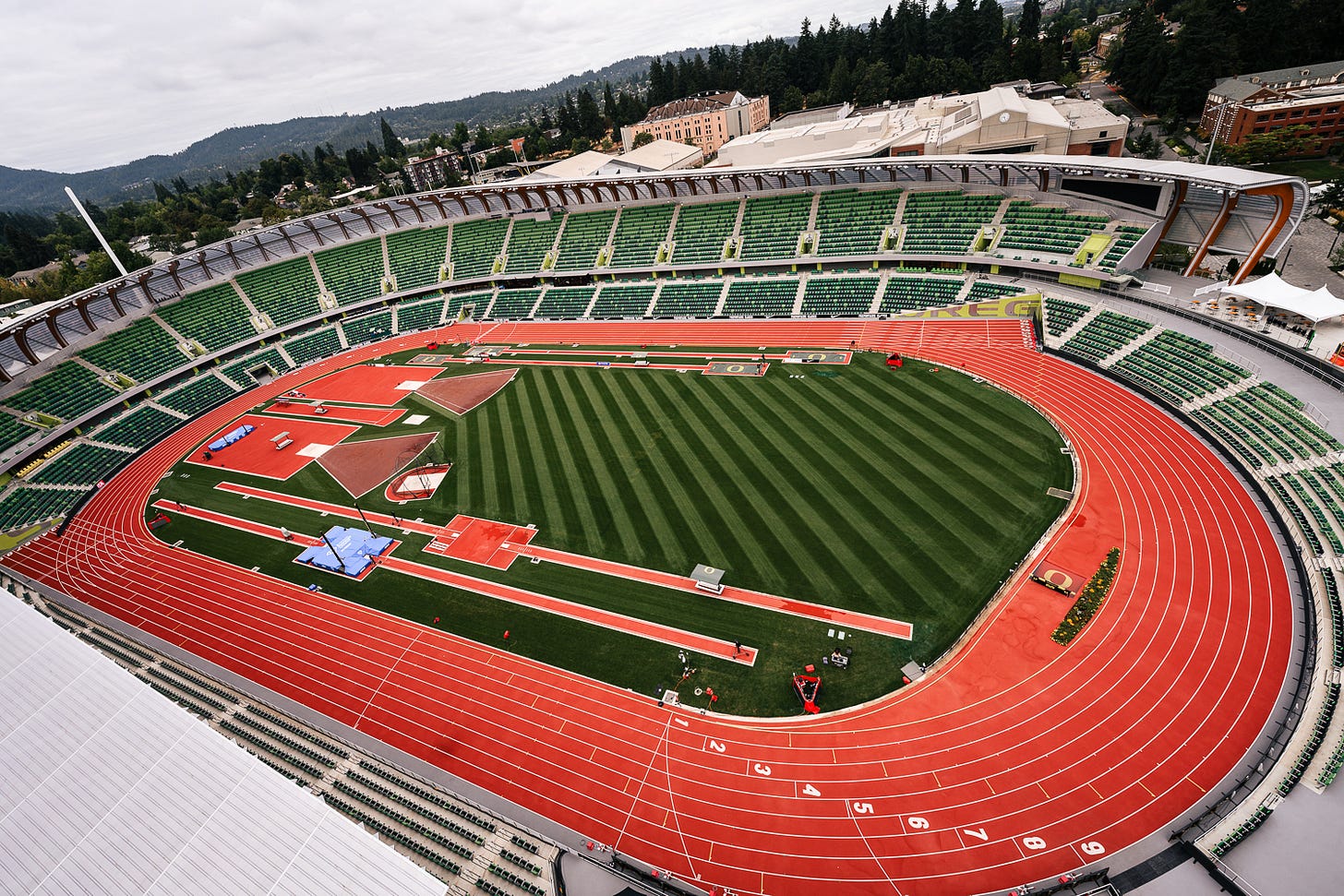
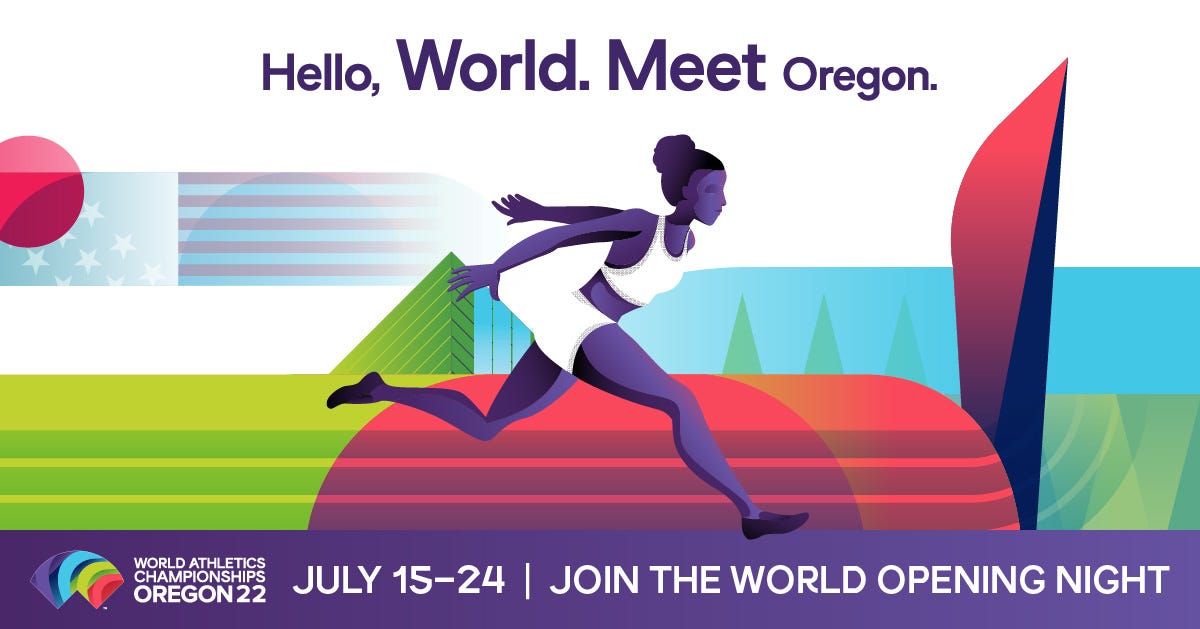
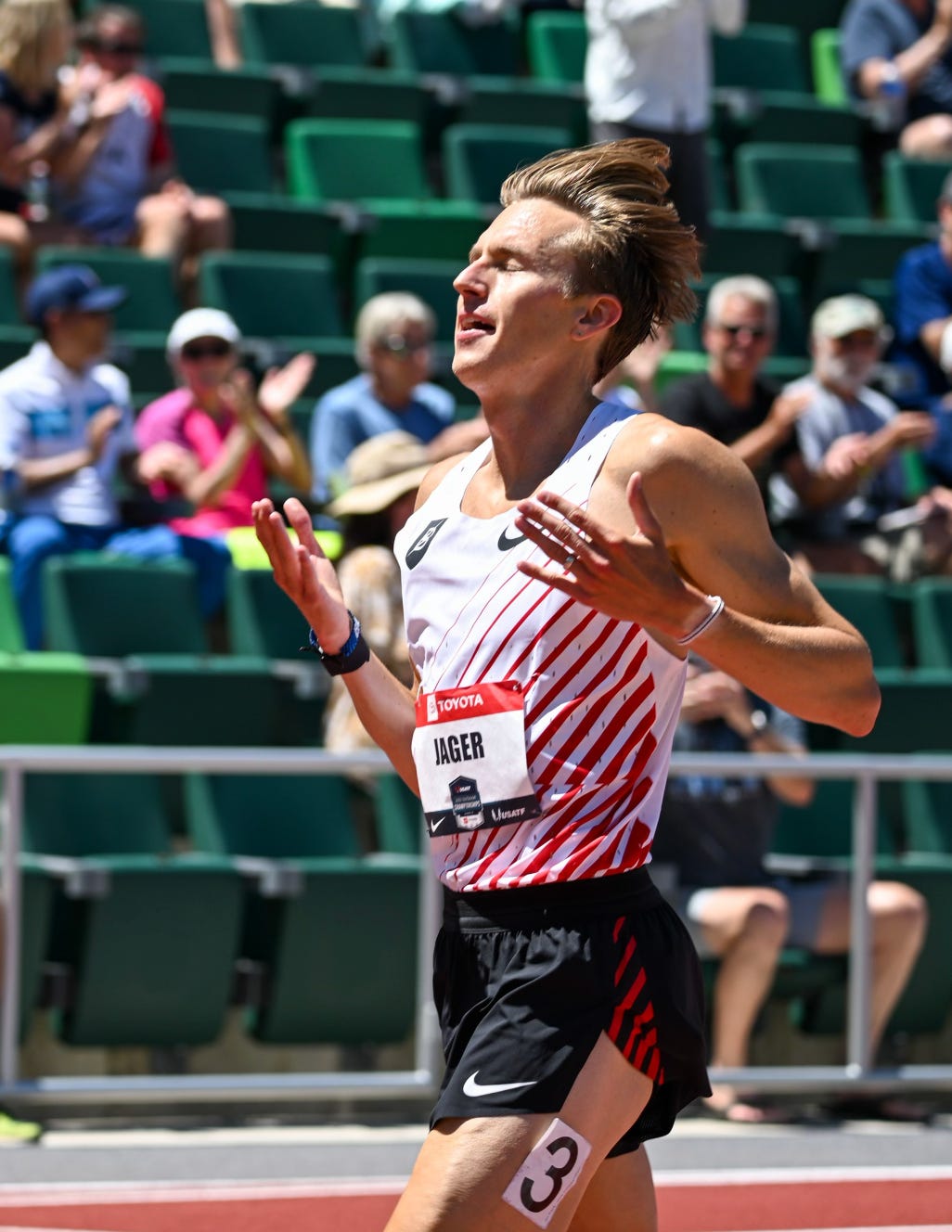
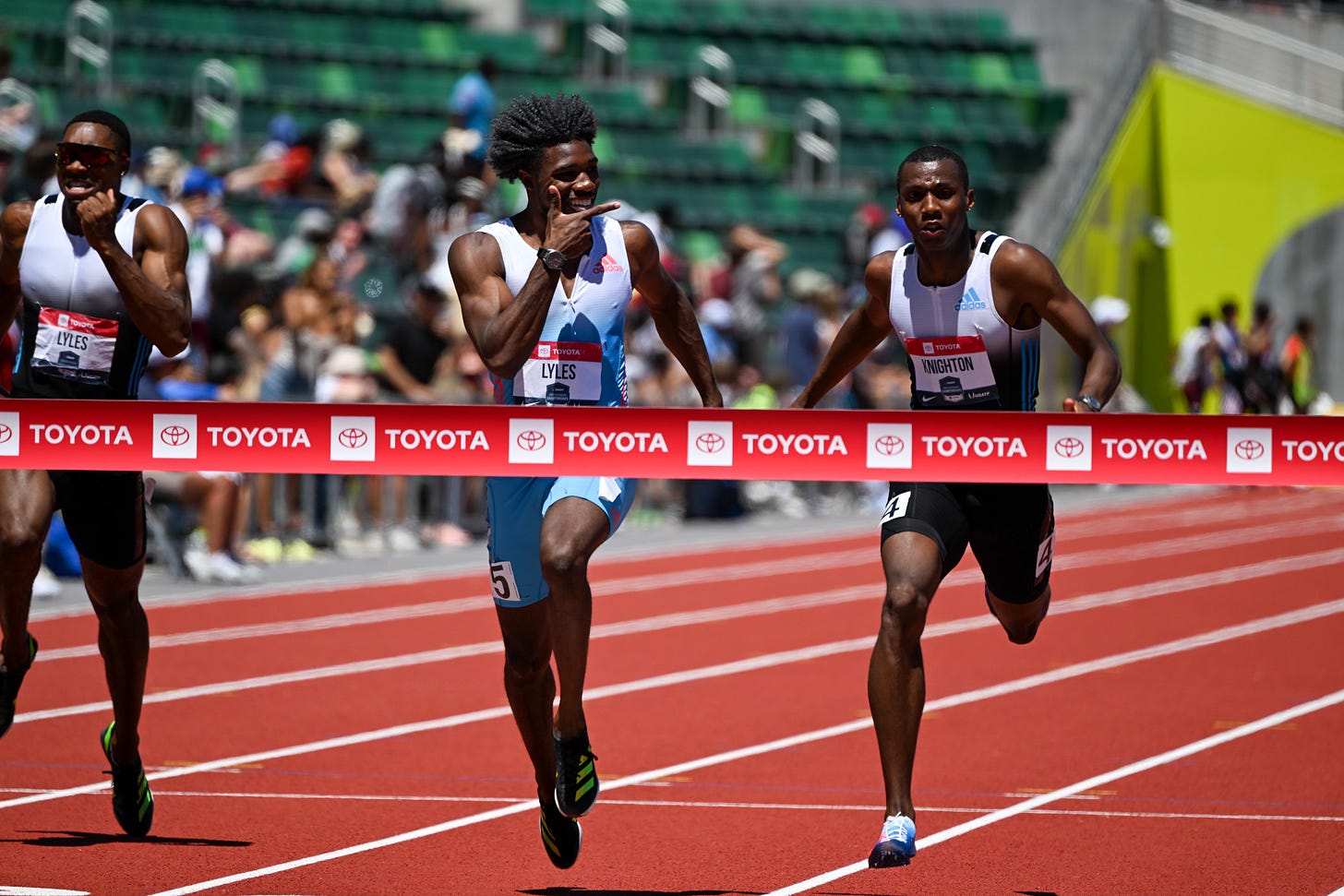
I agree on the point about low attendance . USATF can do a better job with their annual championship meet...especially a WC qualifier. I'm one of those fans that live central and getting out to both USA's and WC was not gonna happen. See you in a couple weeks though! And keep up the great work!
As for locations I would probably go Midwest. Columbus at OSU or Indiana in Bloomington. Great history there. Or you go south to the Carolina’s. Either are easier to get to than Eugene. Between the Trials, Pre, Nat Champs and now Worlds, there are only so many times one wants to make the trip the PAC NW.
Great coverage today in the recap and all of last week.